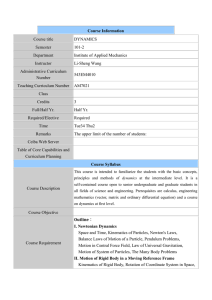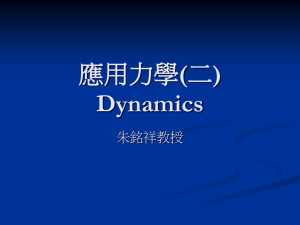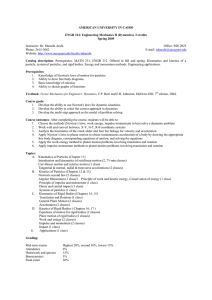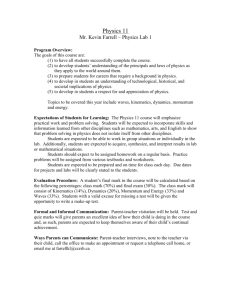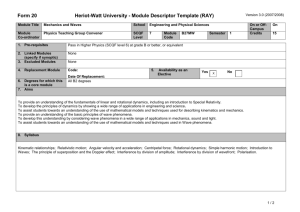BOOK REVIEW
advertisement
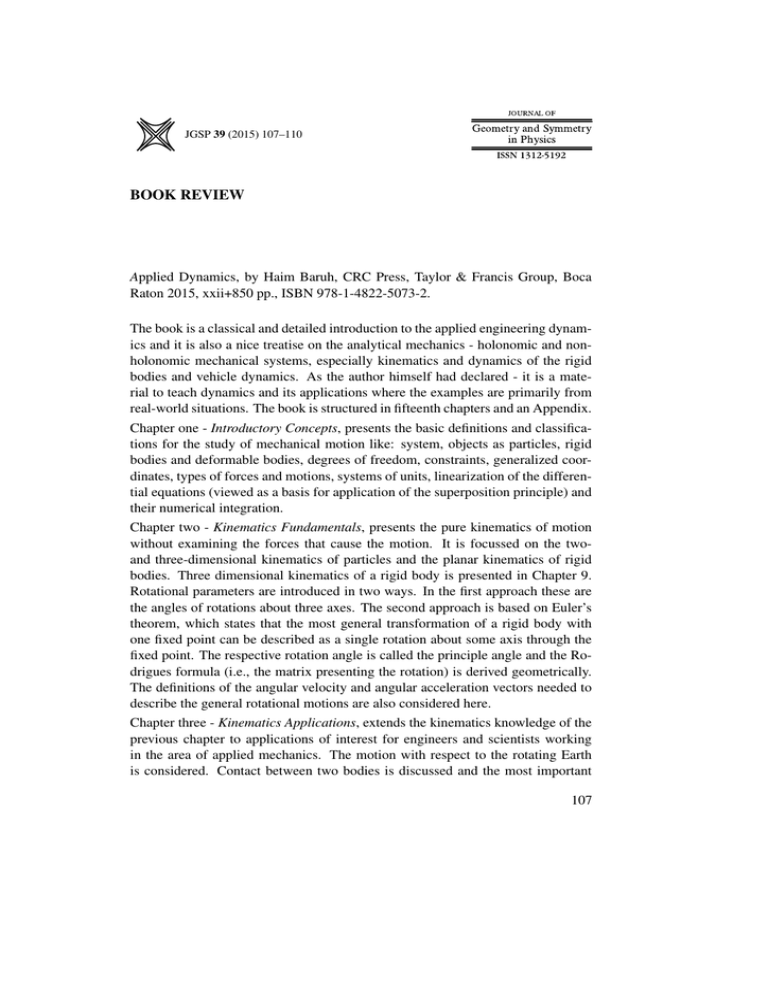
JGSP 39 (2015) 107–110 BOOK REVIEW Applied Dynamics, by Haim Baruh, CRC Press, Taylor & Francis Group, Boca Raton 2015, xxii+850 pp., ISBN 978-1-4822-5073-2. The book is a classical and detailed introduction to the applied engineering dynamics and it is also a nice treatise on the analytical mechanics - holonomic and nonholonomic mechanical systems, especially kinematics and dynamics of the rigid bodies and vehicle dynamics. As the author himself had declared - it is a material to teach dynamics and its applications where the examples are primarily from real-world situations. The book is structured in fifteenth chapters and an Appendix. Chapter one - Introductory Concepts, presents the basic definitions and classifications for the study of mechanical motion like: system, objects as particles, rigid bodies and deformable bodies, degrees of freedom, constraints, generalized coordinates, types of forces and motions, systems of units, linearization of the differential equations (viewed as a basis for application of the superposition principle) and their numerical integration. Chapter two - Kinematics Fundamentals, presents the pure kinematics of motion without examining the forces that cause the motion. It is focussed on the twoand three-dimensional kinematics of particles and the planar kinematics of rigid bodies. Three dimensional kinematics of a rigid body is presented in Chapter 9. Rotational parameters are introduced in two ways. In the first approach these are the angles of rotations about three axes. The second approach is based on Euler’s theorem, which states that the most general transformation of a rigid body with one fixed point can be described as a single rotation about some axis through the fixed point. The respective rotation angle is called the principle angle and the Rodrigues formula (i.e., the matrix presenting the rotation) is derived geometrically. The definitions of the angular velocity and angular acceleration vectors needed to describe the general rotational motions are also considered here. Chapter three - Kinematics Applications, extends the kinematics knowledge of the previous chapter to applications of interest for engineers and scientists working in the area of applied mechanics. The motion with respect to the rotating Earth is considered. Contact between two bodies is discussed and the most important 107 108 Book Review application like rolling as well. The bicycle model of the the car is introduced and the kinematic differential equations behind it are developed in detail. Chapter four - Kinetics Fundamentals, discusses the basic principles of dynamics. Attention is paid to particles kinetics in two and three dimensions and to the planar rigid body dynamics. Expressions for the linear and angular momentum are developed and the translational and rotational laws of motion are given. Various kinds of forces acting on the body like friction, gravity, contact, aerodynamic, springs and dampers are analyzed. Three-dimensional rigid body dynamics is discussed in Chapter 11. Chapter five - Kinetics Applications, is devoted to the applications of the kinetics principles given in the previous chapter. The important mechanical notions like work, energy and power are introduced and exemplified. These are complemented with the notions of the same level of importance in mechanics like linearization, equilibrium and stability. The rolling motion, mechanical trail, impulsive loads, and impact, as well as impulse-momentum and work-energy principles are also considered. The examples given here are for two-dimensional motion of rigid bodies and for three-dimensional motion of particles. Chapter six - Response of Dynamical Systems and Chapter seven - Response of Multi-Degree-Freedom Systems, consider the response of dynamical systems from a quantitative perspective, of linear single-degree-of-freedom and of multi-degrees of freedom dynamical systems respectively. The mathematical basis is the Laplace transform method which allows conversion of the differential equation into algebraic ones and finding the explicit solutions. The resonance and the beat phenomena are also discussed. Chapter eight - Analytical Mechanics, develops analytical techniques for obtaining the dynamical equations. After a discussion of generalized coordinates, generalized velocities and generalized speeds, kinematic variables and virtual displacements are introduced. The principal of virtual displacements for static equilibrium is developed and D’Alembert’s principle is derived as an extension of the principle of the virtual work to the dynamic case, while the Hamilton’s principle, Lagrange’s equations and Kane’s equations are shown to follow from D’Alembert’s principle. Chapter nine - Three-Dimensional Kinematics of Rigid Bodies, which is concerned with the geometry and kinematics of rigid bodies in three-dimensional motion unifies in some sense the concepts introduced earlier in Chapters two to five. Different parameterizations of the rotations (Euler angles, Euler and Rodrigues parameters) and the relations between them are given. The screw axis of an arbitrary rotation, Book Review 109 the translation transformations of the initial vector and the rotation angle are derived explicitly. The important cases of axisymmetric bodies and of rolling are considered. Chapter ten - Mass Moments of Inertia, is a direct continuation of Chapter four and extends the discussion of mass moment of inertia for plane motion to three dimensions. The study of this problem is needed for the analysis of the three-dimensional kinetics, as in description of the angular momentum and kinetic energy in terms of the inertia matrix. The importance of the latter is demonstrated by deriving its explicit form for the case of unbalanced tire. Chapter eleven - Dynamics of Three-Dimensional Rigid Body Motion, is devoted to the space motion of a rigid body and also develops tools for analyzing the qualitative behavior of the motion, such as stability, motion integrals, work-energy principles, and impulse-momentum principles. The main examples are torque-free motion of an axisymmetic body, the spinning top and the rolling disk. Chapters twelve to fifteen are devoted to Vehicle Dynamics, and consider respectively the problems of basic loads and longitudinal motions, tire and aerodynamic forces, lateral stability, and bounce, pitch and roll motions. The importance of the coordinate systems used for describing the vehicle motions is stressed. From a practical point of view - a nice analysis of braking and the brake effects is presented. This is complemented by the study of the effects of tire and aerodynamic forces, rolling resistance and wheel slip. Chapter sixteen - Appendix - Common Inertia Properties, is an useful compendium about inertia matrices of bodies with different geometry and mass distribution. Every chapter contains many examples and many of them end with a bibliography and problems. The Index and nicely printed graphics are informative and of superb quality. As a whole, the book is as an useful tool for undergraduate and graduate students, professors and researchers in the area of theoretical and applied mechanics and mechanical engineering. Readers that are interested more deeply in theoretical and applied mechanics, can have a look besides to the well-known classical books in mechanics, to the list of alternative books given below which contains mostly titles that are published during the last decade. The present book is a valuable addition to this field and probably will serve as a Reference for a long time. 110 Book Review References [1] Jazar R., Vehicle Dynamics: Theory and Application, Springer, New York 2008. [2] Jazar R., Theory of Applied Robotics: Dynamics and Control, 2 nd Edn, Springer, New York 2010. [3] Jazar R., Advanced Dynamics: Rigid Body, Multibody, and Aerospace Applications, John Wiley & Sons, Hoboken 2011. [4] Markley F. and Crassidis J., Fundamentals of Spacecraft Attitude Determination and Control, Springer, New York 2014. [5] Papastavridis J., Analytical Mechanics. A Comprehensive Treatise and the Dynamics of Constrained Systems, World Scientific, Singapore 2014. [6] Selig J., Geometric Fundamentals of Robotics, 2nd Edn, Springer, New York 2005. Clementina D. Mladenova Institute of Mechanics Bulgarian Academy of Sciences Acad. G. Bonchev Str. Bl. 4 1113 Sofia, BULGARIA E-mail address: clem@imbm.bas.bg
